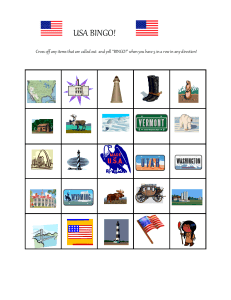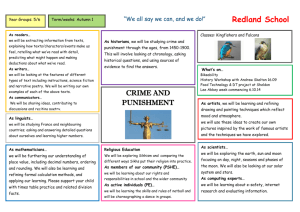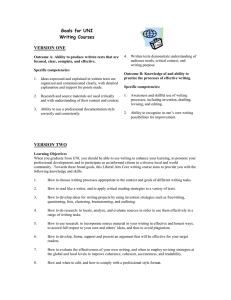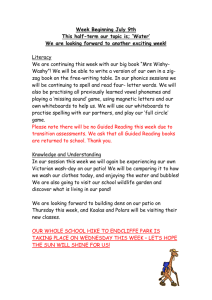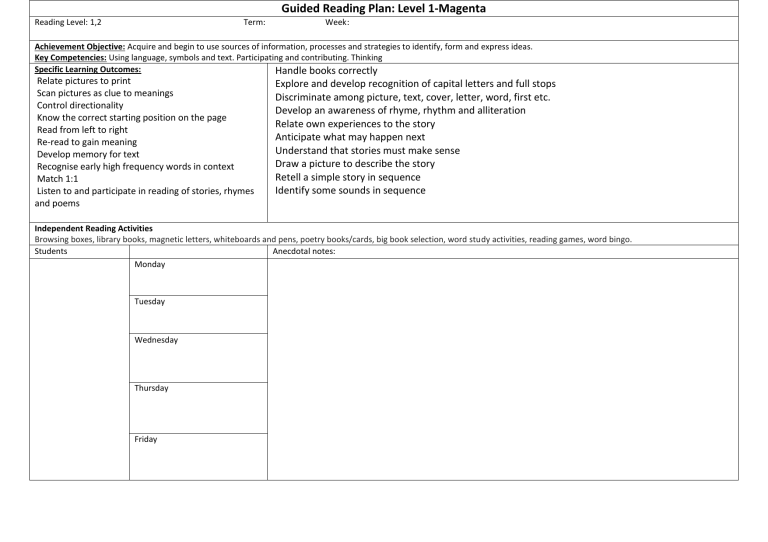
Guided Reading Plan: Level 1-Magenta Reading Level: 1,2 Term: Week: Achievement Objective: Acquire and begin to use sources of information, processes and strategies to identify, form and express ideas. Key Competencies: Using language, symbols and text. Participating and contributing. Thinking Specific Learning Outcomes: Handle books correctly Relate pictures to print Scan pictures as clue to meanings Control directionality Know the correct starting position on the page Read from left to right Re-read to gain meaning Develop memory for text Recognise early high frequency words in context Match 1:1 Listen to and participate in reading of stories, rhymes and poems Explore and develop recognition of capital letters and full stops Discriminate among picture, text, cover, letter, word, first etc. Develop an awareness of rhyme, rhythm and alliteration Relate own experiences to the story Anticipate what may happen next Understand that stories must make sense Draw a picture to describe the story Retell a simple story in sequence Identify some sounds in sequence Independent Reading Activities Browsing boxes, library books, magnetic letters, whiteboards and pens, poetry books/cards, big book selection, word study activities, reading games, word bingo. Students Anecdotal notes: Monday Tuesday Wednesday Thursday Friday Guided Reading Plan: Level 1-Red Reading Level: 3, 4, 5 Term: Week: Achievement Objective: Acquire and begin to use sources of information, processes and strategies to identify, form and express ideas. Key Competencies: Using language, symbols and text. Participating and contributing. Thinking Specific Learning Outcomes: Develop understanding of question marks Make links between illustration and print Build some simple word families Use Directional movement Use terms like character, illustration, true Secure 1:1 matching Read text in unconventional layouts such as speech bubbles Re-read to confirm and self correct Read bisyllabic words such as away with appropriate 1:1 matching Use initial and final letters as cues Discuss favourite books Retain many high frequency words Relate text to own experience Use the terms fiction and non-fiction Notice details in illustrations Demonstrate front and back of book Link the text to meaning Participate in discussions on rhyming words, word endings, Use pictures to predict text full stops and capital letters Identify rhythm, alliteration and rhyming words in text (orally) Predict what the next text might be about Develop a memory for the text Predict the next event in the story Retell a simple story in more detail Provide an alternative ending to a story Identify simple ideas from expository text Describe a character, at a beginning level Independent Reading Activities Browsing boxes , library books, magnetic letters, whiteboards and pens, poetry books/cards, big book selection, word study activities ,reading games, word bingo, listen to reading Students Anecdotal notes: Monday Tuesday Wednesday Thursday Friday Guided Reading Plan: Level 1-Yellow Reading Level: 6, 7, 8 Term: Week: Achievement Objective: Acquire and begin to use sources of information, processes and strategies to identify, form and express ideas. Key Competencies: Using language, symbols and text. Participating and contributing. Thinking Specific Learning Outcomes: Use some letter-sound links correctly in reading Re-read and self-correct when meaning is lost Talk about plot and characters Use initial letters and endings to help decode Discuss favourite books and recommend them to others Scan words and use chunks of letters Discuss a sequence of events Cross-check meaning, structure, grapho-phonic and visual cues Distinguish between fantasy and realism though illustrations, layout and storyline Consolidate awareness of rhyme, rhythm and alliteration Identify speech marks and ellipses Retell the story with greater sophistication Establish concepts about print Explain an idea from factual text Build word patterns using initial consonants, vowels, endings Use the library fully Read text with a variety of prepositions Be enthusiastic about books and reading Understand the difference between questions and answers Grasp the main idea of the story Hear and distinguish the dominant sounds within a word Use illustration, context and own experience to assist with meaning Understand the difference between a letter and a word Independent Reading Activities Browsing boxes, library books, magnetic letters, whiteboards and pens, poetry books/cards, big book selection, word study activities, reading games, word bingo, listen to reading Students Anecdotal notes: Monday Tuesday Wednesday Thursday Friday Guided Reading Plan: Level 1-Blue Reading Level: 9, 10, 11 Term: Week: Achievement Objective: Acquire and begin to use sources of information, processes and strategies to identify, form and express ideas. Key Competencies: Using language, symbols and text. Participating and contributing. Thinking Specific Learning Outcomes: Make inferences and accept other people’s points of view Review structures and word endings Become more fluent Cross-check cues Scan words and sentences Analyse compound words using word analysis skills Develop reading vocabulary Know why question marks, commas, speech marks and ellipses are used Interpret punctuation such as exclamation marks Build word patterns using consonant blends and diagraphs Provide a more developed response to the text Build spelling vocabulary Retell the story in sequence Be confident in attempting to read a variety of books Use terms like author, illustrations, title Identify changes in font Identify different types of text Comment on specific aspects of plot, character and sequence of events Compare books in terms of text, illustrations and print conventions Ask questions about the text Refer to the text to identify information Hear an increasing number of sounds in words for writing independently Negotiate a personal response to the text to share with others Predict ideas in stories with growing confidence and success Cope with the greater complexities of text Become more aware of punctuation and apply this knowledge in oral reading Read silently for a purpose Independent Reading Activities Browsing boxes , library books, whiteboards and pens, poetry books/cards, big book selection, word study activities, reading games, word bingo, listening to reading Students Anecdotal notes: Monday Tuesday Wednesday Thursday Friday Guided Reading Plan: Level 1-Green Reading Level: 12, 13, 14 Term: Week: Achievement Objective: Acquire and begin to use sources of information, processes and strategies to identify, form and express ideas. Key Competencies: Using language, symbols and text. Participating and contributing. Thinking Specific Learning Outcomes: Talk confidently about plot, characters and sequence of events Consistently cross-check cues Summarise discussion about the content of factual text Read punctuation correctly when reading orally Initiate a personal response to text and share with others Read selectively for pleasure and information Give an alternative ending to a story Create meaning from an increasingly wide range of texts and Use appropriate reading strategies more frequently illustrations Build knowledge of word patterns, blends such as thr and root Read for meaning and understanding words Be confident about taking risks and making approximations in reading and writing Identify poems, letters, instructions, notices and plays Increase skill in reasoning and predicting Identify features such as headings and diagrams Increase independence in reading a variety of books Use punctuation correctly in writing Read silently for a purpose Recognise an increasing number of contractions Discuss book characters, scenes and episodes with Develop expressive oral reading using punctuation understanding Distinguish between direct and indirect speech Habituate concepts about print Understand there may be more than one interpretation of a text Independent Reading Activities Browsing boxes , library books, magnetic letters, whiteboards and pens, poetry books/cards, big book selection, word study activities, reading games, word bingo, listen to reading Students Anecdotal notes: Monday Tuesday Wednesday Thursday Friday Guided Reading Plan: Level 1-Orange Reading Level: 15, 16 Term: Week: Achievement Objective: Acquire and begin to use sources of information, processes and strategies to identify, form and express ideas. Key Competencies: Using language, symbols and text. Participating and contributing. Thinking Specific Learning Outcomes: Be confident about changes of font Integrate the use of cues across a range of texts Make more in-depth predictions and justifications Read with fluency and expression Make more sophisticated inference from text Analyse multisyllabic words in text Ask others questions during discussions Be conversant with a wide range of genres Discuss plot, setting and character Identify and name features such as blends and alliteration Summarise text in detail on own words Be conversant with paragraphs Innovate on a wide variety of text types Use contractions from a base of consolidated Use a dictionary to find the meaning of words knowledge Build a secure bank of high frequency words Be conversant with fables, myths, legends and fairy stories Re-run and read on to gain meaning Understand and use a table of contents Read independently by choice Read with increased fluency and phrasing Independent Reading Activities Browsing boxes, library books, magnetic letters, whiteboards and pens, poetry books/cards, big book selection, word study activities, reading games, word bingo, listen to reading Students Anecdotal notes: Monday Tuesday Wednesday Thursday Friday Guided Reading Plan: Level 1-Turquoise Reading Level: 17, 18 Term: Week: Achievement Objective: Acquire and begin to use sources of information, processes and strategies to identify, form and express ideas. Key Competencies: Using language, symbols and text. Participating and contributing. Thinking Specific Learning Outcomes: Realise that they may not agree with everything that is read Read text with complex sentence structure Compare different styles of illustrations Read more challenging vocabulary Take initiative in responding to books Enjoy reading longer stories and articles Talk about own interpretation of text such as advertisements Draw inferences from text Use references such as atlases and dictionaries Know the purpose of headings, diagrams, tables of contents and indexes Use a table of contents and index Be conversant with a range of contractions Look at deeper meaning in stories where not everything is spelt out Recognise and use compound words Justify own opinions of text Develop a curiosity about language and words Discuss setting of a story Relate text to the world around them Independent Reading Activities Browsing boxes, library books, magnetic letters, whiteboards and pens, poetry books/cards, big book selection, word study activities, reading games, word bingo, listen to reading Students Anecdotal notes: Monday Tuesday Wednesday Thursday Friday Guided Reading Plan: Level 1-Purple Reading Level: 19, 20 Term: Week: Achievement Objective: Acquire and begin to use sources of information, processes and strategies to identify, form and express ideas. Key Competencies: Using language, symbols and text. Participating and contributing. Thinking Specific Learning Outcomes: Point out and explain features such as table of contents, index, diagrams, maps and headings Read a range of texts silently Be conversant with terms such as chapter, event, question and comment Read for pleasure Discuss major characters, minor characters, the parts they play , the sequence of events Read texts with more specialised vocabulary Compare and contrast settings of stories Maintain meaning over longer and more complex structures Justify own opinions of text Discuss own purpose for reading Talk confidently about books and authors when reporting and Discuss morals and values retelling Discuss in detail differences between fact and fiction Summarise a range of texts in detail Compare storylines of books read Confidently ask others questions during Understand varying points of view Justify own reading choices Independent Reading Activities Browsing boxes, library books, magnetic letters, whiteboards and pens, poetry books/cards, big book selection, word study activities, reading games, word bingo, listening to reading Students Anecdotal notes: Monday Tuesday Wednesday Thursday Friday Guided Reading Plan: Level 2-Gold Reading Level: 21, 22 Term: Week: Achievement Objective: Acquire and begin to use sources of information, processes and strategies to identify, form and express ideas. Key Competencies: Using language, symbols and text. Participating and contributing. Thinking Specific Learning Outcomes: Discuss book characters, scenes and episodes with confidence Read a wide range of texts for pleasure and information Identify common features of different stories by the same author Skim a range of texts, locate specific information and Compare concepts such as setting, theme, plot and characters summarise in own words Discuss morals and values in greater depth Cope with more complex characters and less predictable Recognise a story within a story storylines Respond critically to a range of texts Extend reading interests Build on or respond to comments about books Use a table of contents, glossary and index with confidence Compare and contrast information such as the features of different stories or factual texts Use headings, diagrams, maps, graphs and tables to scan and Summarise different texts in different ways (such as key ideas) locate information in a variety of texts Use information from a text to present a poster Ask reflective questions Be enthusiastic about extending reading interests Use the library effectively as a source of information Sustain long periods of silent reading Respond critically to both fiction and non-fiction texts Independent Reading Activities Browsing boxes , library books, magnetic letters, whiteboards and pens, poetry books/cards, big book selection, word study activities, reading games, word bingo, listen to reading Students Anecdotal notes: Monday Tuesday Wednesday Thursday Friday Guided Reading Plan: Level 2-Silver Reading Level: 23, 24, Term: Week: Achievement Objective: Acquire and begin to use sources of information, processes and strategies to identify, form and express ideas. Key Competencies: Using language, symbols and text. Participating and contributing. Thinking Specific Learning Outcomes: Identify and reflect on information while reading Read a wide range of genres for pleasure and information Listen to and interact with others when discussing issues that arise in different text forms Clarify vocabulary or meaning independently Justify their own opinion about the story Skim a range of texts, locate specific information and Identify literal meaning summarise in their own words Identify inferential meaning Extend reading interests Compare and contrast information such as the features of different stories or factual texts Use a table of contents, glossary and index with confidence Use key words effectively Use headings, diagrams, maps, graphs and tables to scan and Locate key information and content locate information in a variety of texts Use a dictionary and thesaurus Identify homonyms, synonyms and antonyms Use information technology to access material in a library Identify how the author uses language to convey meaning and influence the reader Independent Reading Activities Browsing boxes, library books, magnetic letters, whiteboards and pens, poetry books/cards, big book selection, word study activities, reading games, word bingo, listen to reading Students Anecdotal notes: Monday Tuesday Wednesday Thursday Friday



